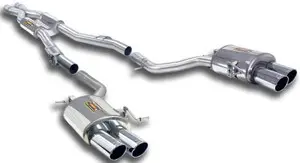
Exhaust leaks: how to find and fix them
Content
Exhaust leaks may be the last thing you want to deal with as a driver. They make annoying noises, affect the performance of your vehicle, can be harmful to the environment, and in rare cases can even be dangerous if they are too close to fuel or flammable parts. Luckily, you can find exhaust leaks and fix them yourself. Performance Muffler experts provide tips and tricks on how to deal with an exhaust leak yourself.
How the exhaust system works
If you are looking for information on how exhaust systems work, take a look at some of the other blogs to better understand how the exhaust system plays a role in your car's performance:
- What does a dual exhaust system do?
- Do exhaust tips change the sound your car makes?
- Muffler repair: everything you need to know
How to find an exhaust leak
The first step to solving any problem is to identify it. Exhaust pipes can get hot, so it's a good idea to check for leaks when the car is cold and hasn't been driven for a long time. A leak usually occurs in one of three areas:
- Motor Mounting Surface
- downpipe/catalyst
- The manifold itself, which is a cast iron and stainless steel assembly that collects gas from different cylinders and directs them through the exhaust pipe, can crack.
With these areas in mind, you can begin your inspection with skill. First, open the hood and check the exhaust manifold. You may not be able to see the collector if it is covered by a heat shield, but you can still listen near the top of the collector. A leak can make a variety of sounds, but it can be audible by increasing the engine speed, which will change the frequency of the leak noise. Thus, it can help you distinguish it from any other strange noises such as engine knock or lift noise.
A ticking sound that seems to be down the engine likely indicates that the problem is with either the flange gasket connecting the manifold or the catalytic converter. When the car is cold, you can put it on the ramps to carefully monitor and inspect the exhaust system. Feel the air around the pipes for leaks.
How to Fix an Exhaust Leak
In the event of a leak in the manifold or connections, replacing the failed gasket will stop the leak. Each joint has an interchangeable gasket for a comfortable fit. The only problem may be rusty nuts or bolts, making them difficult to remove. When you repair a leak in a joint, you must ensure that the surfaces are clean. Material can build up on an old gasket, so a wire brush can be helpful in cleaning up any buildup.
If you are replacing a muffler, resonator, or catalytic converter, be aware that these items may be welded in place rather than secured with clips or bolts. Most likely, you will have to cut out the details with a hacksaw or reciprocating saw. If you ever have any doubts or concerns about your process, feel free to contact Performance Muffler professionals to help fix your exhaust leak.
For any quick and temporary fixes, epoxy and tape will work. But you'll want to clean these surfaces prior to application so they can have optimal impact. A fix like this can take a decent amount of time, but remember that this is just a temporary fix for any emergency. It is better to deliver your car to professionals as soon as possible.
Final thoughts
The exhaust system of a car is a vital component to the performance and life of your vehicle. Do not mess with or sit on the exhaust leak for a long time. This will damage your car. Let the car stand and try to find and fix the problem yourself. If you find that the problem is too serious to deal with on your own, contact the professionals who will take care of your trip efficiently and inexpensively.
About performance silencer
Performance Muffler is a garage for people who "understand". First opening our doors in 2007, we've been the premier custom exhaust shop in the Phoenix area ever since. Visit our website to see how we stand out for our quality, experience and customer service.

